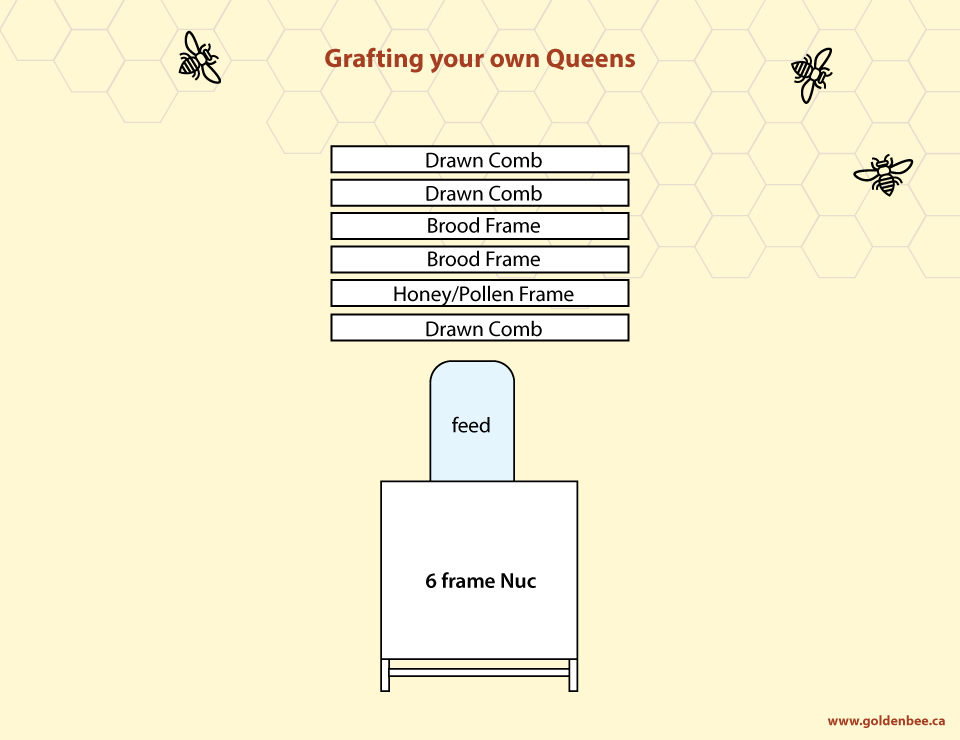How to make Nucs

Making nucs is a great way to increase the number of hives you have or to make a little extra revenue selling them. During the past 5 years there has been a push towards more sustainable beekeeping methods. Queen rearing and making nucs are two essential components of having a sustainable apiary.
How to make a Nuc
In order to make a nuc, you need to find the following frames from a strong donor hive:
- At least 2 frames of brood
- 1 frame of pollen/honey
You will pull these frames from a donor hive. They don’t necessarily have to be from the same hive, multiple hives can be used to make up a single nuc. However, a strong hive should have no problem donating 3 frames in late spring. I prefer to use hives that will become a swarming risk later in the year. Place the three frames as outlined in the picture below in the center of drawn comb.
To Move or Not to Move
When you are finished making up the nuc, close up the lid and move the nuc 3 miles away from the donor hives so the bees don’t fly back to the donor hives. This isn’t a requirement, but I’ve discovered that nucs do much better if they are moved. You will have more bees and more bees = stronger nucs.
If moving isn’t an option, the nucs can stay in the same yard. This can work, but it will take much longer for them to get established. That is because all the forager bees (bees that leave the hive) will fly back to the donor hive and you will be left with only younger nurse bees that that have never left their origional hives.

What about the Queen?
All nucs require a new queen. You have two options:
- Add a mated queen
- Add a queen cell
Either option will work but they require different approaches.
If you add a mated queen, you can add a new caged queen right away or leave them queenless for 24 hours. I’ve never noticed a difference with acceptance so I usually add a caged queen right away to save the extra trip to the nuc yard. The queen needs to stay caged for 3 days so the bees get use to the queen pharamones.
If you add a queen cell, it’s all about timing when you make the nucs. You need to make the nucs two days before the virgin queen is scheduled to hatch. This will give the nuc 24 hours time to realize they are queenless. The day after you make the nucs, add a queen cell between the two center frames. This will the bees 24 hours to realize they have a queen cell. After adding a queen cell, wait 2-3 days before checking if they are hatched. If they are hatched, remove the cell and leave the nuc alone for about two weeks. Do not inspect or distrub a hive/nuc with a virgin queen. You increase the risk of the virgin queen being killed if you disturb it too often. Virgin queens are also very flighty and you risk having her fly away on you.
Leave the nuc alone for two weeks and if all goes well, you should find a mated queen that has started laying eggs. This is one of the most rewarding aspects of beekeeping for me.
Nuc Size
Nucs can be many different sizes and the size is usually beekeeper preference. Nucs can be anywhere between 3 – 6 frames. We use 6 frame nucs because it’s large enough so when you transfer established nucs to 10 frame equipment, they have no problem adjusting. 6 frame nucs also winter well here in Manitoba

November 26, 2021 @ 4:11 pm
Thank you so much for the very helpful information from a reader in New Zealand.